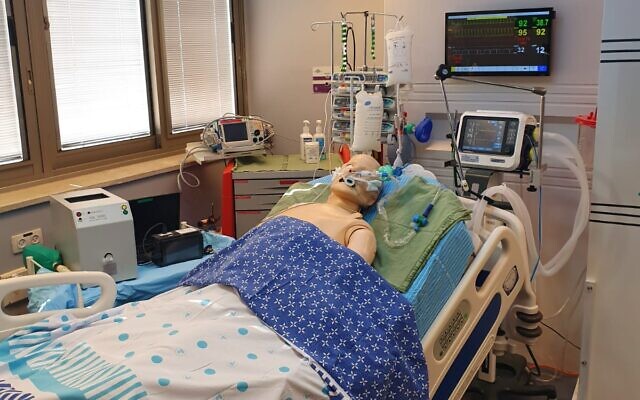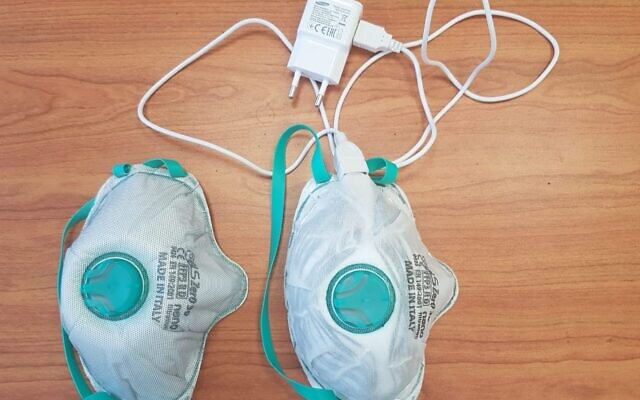Letting robots and AI do much of the heavy lifting and keeping
doctors and nurses safely away from an infectious patient with augmented
reality goggles, an Israeli medical center at the forefront of the
COVID-19 fight unveiled what it said was the “hospital room of the
future” Tuesday.
Sheba Medical Center said it was not waiting for the future to
integrate the new technologies, though, as it sought to prepare for a
feared second wave of the coronavirus even as the pandemic has taken an
increasingly minor role in Israeli public life.
“The technologies we’re introducing, and have brought in recently,
will give us an edge in our preparedness for a second wave,” predicted
Eyal Zimlichman, Sheba’s chief medical officer.
He said that his hospital, just outside Tel Aviv, was the largest
recipient of coronavirus cases in Israel to date, and is “very much more
prepared” for a second wave than it was for the first wave.
Zimlichman spoke to The Times of Israel after an hour-long online
event on Tuesday, during which he commented on footage shot in a new
room built in the Sheba-based Israel Center for Medical Simulation. The
“room of the future” is a facility used for trying out new innovations
used by teaching staff. It is a model for how staff hope that rooms
across the campus will start to look as innovations are rolled out over
the coming months.
The room includes more than a
dozen technologies that were deployed in recent weeks or will be
deployed soon in parts of the hospital, especially in the 450-bed
coronavirus facility. Sheba has played a part in developing some of the
innovations, but not all of them.

Eyal Zimlichman, chief medical officer at Sheba Medical Center in Ramat Gan (courtesy of Sheba Medical Center)
The hospital has long been working on boosting the role of technology
in patient care but COVID-19 has been a major “accelerator” for digital
health, said Zimlichman. He explained that the pandemic has forced
staff to think creatively in order to care for the complex needs of
patients while minimizing direct contact with them.
“Some of these solutions had already been tested at Sheba, but it
was just COVID-19 that propelled us to push this to the front lines and
get it to work,” Zimlichman said.
The webinar — titled HealthSpace 2030, because Sheba intended it
to kickstart a conversation about what patent care will look like in a
decade — showed footage of doctors treating an actor playing the part of
hypothetical 40-year-old coronavirus patient Joel Cohen. A robot
connected him for a video call with his wife, a sensor under his
mattress monitored various stats, a nurse used virtual reality coaching
to fix a ventilator, and artificial intelligence helped doctors catch a
deterioration before it happened.

An actor in Sheba Medical Center’s
“hospital room of future” uses a smart thermometer to transmit his
temperature to a doctor (courtesy of Sheba Medical Center)
One feature of the new hospital room is a device that the patient
operates to conduct tests based on the instructions of a doctor or nurse
who talks to them via a screen. In the simulation, a doctor told the
patient to attach a thermometer and other accessories to get a picture
of his health.
For many conditions, doctors want technology to give early
warning of deterioration, but this is particularly needed for the
coronavirus, said Zimlichman. The disease can involve a sudden demise,
and doctors are desperate to receive early warnings. “It has been
critical for us to be able to monitor patients and see a few hours in
advance when they are going to deteriorate,” he explained.
Doctors at Sheba already place sensors under
mattresses in some wards to track heart-rate, respiratory rate and
movement, artificial intelligence processes the data, and alerts doctors
if patients look likely to take a turn for the worse. “It typically
gives us a signal four to six hours before a deterioration,” said
Zimlichman, adding that this is valuable time in the case of coronavirus
patients.
Another alert system, still in development
by Sheba and a private sector partner, is an app that monitors a
patient’s voice when they talk on their cell phone. It can pick up
changes in voice – or breathing – that can indicate a deterioration is
likely, and alert the medical team if this is detected.

A nurse wearing protective gear and a
pair of Microsoft HoloLens 2 glasses uses augmented reality
functionality to perform maintenance tasks in Sheba Medical Center’s
“hospital room of the future” (courtesy of Sheba Medical Center)
With technology comes the risk of technical problems, so the new
patient room includes a function that allows tech support teams for the
various devices to help doctors and nurses fix glitches by giving
demonstrations using augmented reality. They wear Microsoft HoloLens 2
“mixed reality smart glasses.”
Zimlichman said that augmented reality has been in use throughout the
pandemic and has proved helpful, as it is challenging to kit
technicians in protective gear to carry out maintenance activities on
virus wards.
Amitai Ziv, director of the Israel Center
for Medical Simulation, said he was particularly pleased to see defense
companies getting involved in healthcare. “We’re very very privileged by
the fact that we found ourselves, so to speak, shifting the killing
industry into the healing industry,” he said.
“Killing is not a nice word, defense is
better, but a lot of those startups that we have seen, and more solid
companies that are out there in the field of defense… moved and found
themselves in the field of healing, and that’s something that made us
all very proud.”


&cid=&e=5461259551b4a893fe0c287100d45c8f27d93dc212ee50c4fcc479f4fac225ef&c=proclivity_94358&pubid=202&siteid=20229&p=1)

&cid=&e=5461259551b4a893fe0c287100d45c8f27d93dc212ee50c4fcc479f4fac225ef&c=proclivity_94358&pubid=202&siteid=20229&p=2)

&cid=&e=5461259551b4a893fe0c287100d45c8f27d93dc212ee50c4fcc479f4fac225ef&c=proclivity_94358&pubid=202&siteid=20229&p=3)
&cid=&e=5461259551b4a893fe0c287100d45c8f27d93dc212ee50c4fcc479f4fac225ef&c=proclivity_94572&pubid=202&siteid=20229&p=1)

&cid=&e=5461259551b4a893fe0c287100d45c8f27d93dc212ee50c4fcc479f4fac225ef&c=proclivity_94572&pubid=202&siteid=20229&p=2)
&cid=&e=5461259551b4a893fe0c287100d45c8f27d93dc212ee50c4fcc479f4fac225ef&c=proclivity_94572&pubid=202&siteid=20229&p=3)










